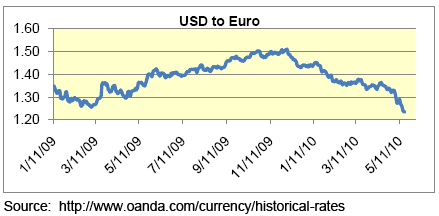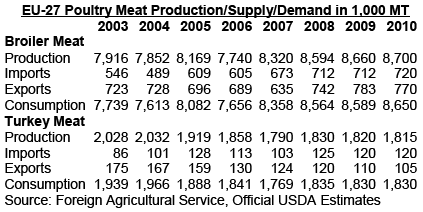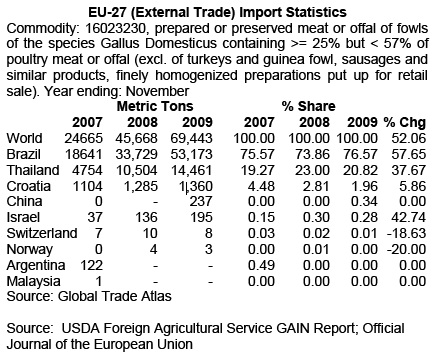



International Egg and Poultry Review: EU
EU - This is a weekly report by the USDA's Agricultural Marketing Service (AMS), looking at international developments concerning the poultry industry. This week's report focuses on the impacts of the EU-27 Broiler Welfare Directive and Poultry Marketing Regulation, which comes into effect on 1 July 2010.1 July 2010 is the final implementation date of Council Directive 2007/43/EC of 28 June 2007, known as the poultry welfare directive. This directive lays down minimum rules for the protection of chickens kept for meat production. As a general rule, this directive limits the stocking densities of poultry to 33 kg per square metre, although Member States may still allow higher stocking densities under certain conditions. When an exemption is granted for higher stocking densities the maximum stocking density cannot exceed 39 kg per square metre.
It is likely that, as a consequence of this new legislation, new labelling requirements for poultry imports will be installed, as Article 5 of this directive specifically mentions that the EU will submit a proposal in this context before the end of 2009.
On 1 July 2010, Commission Regulation 543/2008 comes into force. This regulation updates the EU’s marketing standards for poultry. It more clearly defines fresh poultry meat and does not allow thawed and further prepared poultry meat to be sold as fresh. It also tightens standards on water content in poultry.
Broiler meat production is forecast to grow less than one per cent in 2010 due to the negative impact of the global financial crises on meat consumption in Europe combined with stable poultry meat trade; turkey meat production is forecast to decrease slightly. However, profitability is expected to increase due to lower grain prices reducing producers’ costs. Poultry meat is the least expensive source of protein and has weathered the economic recession better than other meats. Several market analyses showed that while consumers switched from beef or pork to poultry meat, low income consumers simply reduced their protein purchases, switching to carbohydrate products (bread, pasta). Per capita consumption of broiler meat is forecast to increase slightly while turkey meat consumption remains unchanged.

EU broiler exports are expected to continue to face strong competition on the world market, especially from Brazil, but may benefit from the recent drop in the value of the Euro compared to other currencies. The Euro has fallen from a high of US$1.5091 on 4 December 2009 to US$1.233 on 18 May 2010.

Exports of French whole chicken to the Middle East are expected to remain stable. Russia is expected to remain the main primary destination for EU-27 broiler meat exports in 2010, followed by Saudi Arabia, Hong Kong and Benin. EU exports to the Ukraine are not expected to recover due to the currency issue and likely political instability. EU meat exports to Russia were severely hampered in 2009 as Russia implemented stricter hygiene and residue standards. Most EU exporters were relisted for exports to Russia towards the end of 2009 after the EU agreed to meet the stricter standards and processors implemented them. Long term exports to Russia are uncertain as Russia is systematically decreasing meat import quotas yearly with the goal of reaching self-supply sufficiency around 2012.

EU-27 imports of preserved and cooked broiler meat have gone from non-existent to close to 3,800 metric tons (MT) in 2009 and could reach 10,000MT in 2010 according to some analysts. The EU has started negotiations with exporting countries, mainly Brazil and Thailand, on redefining certain tariff lines that are believed to offer new loopholes for exporters to evade out-of-quota duties on poultry exports. Processed poultry under HS 16023230 increased rapidly to almost 50,000MT in 2008 and even 75,000 MT in 2009. These imports benefit from an ad valorem duty level of 10.9 per cent, compared to a fixed duty of €102.4 per 100kg net for out of quota imports under HS 16023219. The in-quota tariff for HS 16023219 is eight per cent. By adding non-meat product to processed poultry to bring the poultry meat content below 57 per cent, exporters can extend low-duty poultry exports to the EU beyond fixed quota numbers.

Further Reading
| - | You can view the full report by clicking here. |











